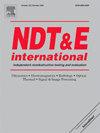一种基于磁电复合材料的准静态漏磁检测方法
IF 4.5
2区 材料科学
Q1 MATERIALS SCIENCE, CHARACTERIZATION & TESTING
引用次数: 0
摘要
漏磁检测广泛应用于铁磁材料的结构损伤监测。然而,由于集肤效应,交流MFL在识别埋藏缺陷方面遇到了挑战。直流磁控漏磁在强磁场作用下,会在材料表面产生剩磁,并对漏磁场信号产生干扰。为此,本文提出了一种基于磁电复合材料的准静态磁漏磁检测方法。利用磁致伸缩曲线的非线性特性,采用变频技术实现了metglass /PZT复合材料中准静态漏磁场的检测。理论分析和仿真研究证明了该方法的可行性。其次,制作了所提出的MFL检测探头,并建立了相应的缺陷检测实验平台。实验结果表明,该方法对0.5 mm宽的表面缺陷具有较高的灵敏度,而采用直流磁化的方法由于剩磁的干扰,信号波动较大,甚至导致缺陷遗漏。准静态磁化条件下的ME信号与缺陷深度也表现出良好的线性关系。对于亚表面缺陷,0.5 Hz和1.0 Hz能够检测到最大深度为9mm的缺陷(接近直流磁化),并且缺陷信号大于直流磁化信号。总之,本文提出的方法对表面缺陷和亚表面缺陷的检测效果都很好。本文章由计算机程序翻译,如有差异,请以英文原文为准。
A quasi-static magnetic leakage detection method based on magneto-electric composite
Magnetic flux leakage (MFL) testing is widely used for structural damage monitoring of ferromagnetic materials. However, AC MFL encounters challenges in identifying buried defects due to the skin effect. DC MFL induces residual magnetism on the material surface under the influence of a strong magnetizing field, which often interferes with the leakage field signal. Therefore, this paper presents a quasi-static MFL detection method based on magneto-electric (ME) composite. By using the nonlinear characteristics of magnetostrictive curves, the detection of quasi-static magnetic leakage fields in Metglas/PZT composites is realized by frequency conversion technique. The feasibility of the method is demonstrated by theoretical analysis and simulation studies. Next, the proposed MFL detection probe is fabricated and the corresponding experimental platform for defect detection is established. The experimental results show that the proposed method has a high sensitivity for surface defects of 0.5 mm width, while the method using DC magnetization has large signal fluctuations and even leads to defect omission due to the interference of residual magnetism. The ME signal under quasi-static magnetization also exhibits a good linear relationship with defect depth. For subsurface defects, 0.5 Hz and 1.0 Hz are capable of detecting defects up to a maximum depth of 9 mm (close to DC magnetization) and the defect signal is larger than the DC magnetization signal. In conclusion, the proposed method demonstrates outstanding detection performance for both surface and subsurface defects.
求助全文
通过发布文献求助,成功后即可免费获取论文全文。
去求助
来源期刊

Ndt & E International
工程技术-材料科学:表征与测试
CiteScore
7.20
自引率
9.50%
发文量
121
审稿时长
55 days
期刊介绍:
NDT&E international publishes peer-reviewed results of original research and development in all categories of the fields of nondestructive testing and evaluation including ultrasonics, electromagnetics, radiography, optical and thermal methods. In addition to traditional NDE topics, the emerging technology area of inspection of civil structures and materials is also emphasized. The journal publishes original papers on research and development of new inspection techniques and methods, as well as on novel and innovative applications of established methods. Papers on NDE sensors and their applications both for inspection and process control, as well as papers describing novel NDE systems for structural health monitoring and their performance in industrial settings are also considered. Other regular features include international news, new equipment and a calendar of forthcoming worldwide meetings. This journal is listed in Current Contents.
 求助内容:
求助内容: 应助结果提醒方式:
应助结果提醒方式:


